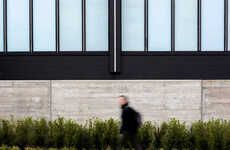
The Wiener Musikhaus Brings the People and Students Together
Jamie Danielle Munro — June 26, 2014 — Art & Design
References: why-how-what.eu & designboom
The Wiener Musikhaus in Vienna is based off designs from ancient Greek theater, meaning much of the building is open to the public. This encourages a relationship between students and the city, instead of having these as two separate entities.
The school consists of both a learning center as well as a concert hall intended for professional musicians. The thinking behind this is that the students will then have access to world-class performers, which will hopefully influence their own studies and outlook on the profession.
According to DesignBoom, "the Greeks built theaters that were based on the premise that they would bring people together," which is exactly what Why-How-What architecture firm was aiming to do with this design.
Photo Credits: designboom, why-how-what.eu
The school consists of both a learning center as well as a concert hall intended for professional musicians. The thinking behind this is that the students will then have access to world-class performers, which will hopefully influence their own studies and outlook on the profession.
According to DesignBoom, "the Greeks built theaters that were based on the premise that they would bring people together," which is exactly what Why-How-What architecture firm was aiming to do with this design.
Photo Credits: designboom, why-how-what.eu
Trend Themes
1. City-connected Music Schools - Creating innovative music schools that foster a relationship between students and the surrounding city.
2. Open and Accessible Learning Centers - Designing learning centers that are open to the public, allowing students to interact with world-class performers.
3. Integration of Professional Concert Halls - Incorporating concert halls within music schools to provide students with exposure to professional musicians.
Industry Implications
1. Education - Opportunity for educational institutions to reimagine their spaces and create unique learning environments that foster community engagement.
2. Music - Disruptive innovation opportunity for the music industry to integrate education and performance spaces, bridging the gap between students and professional musicians.
3. Architecture - Innovative design opportunities for architectural firms to create multifunctional spaces that promote interaction between different community stakeholders.
0.9
Score
Popularity
Activity
Freshness























